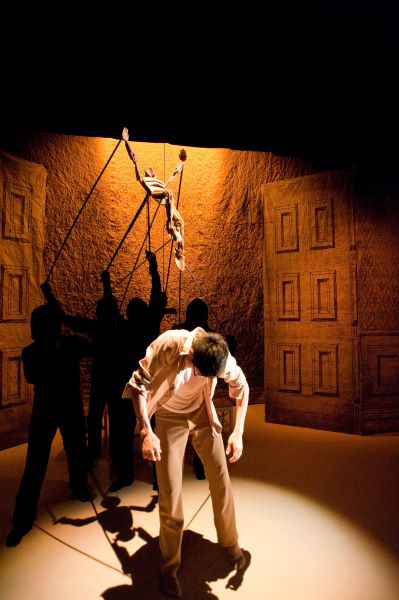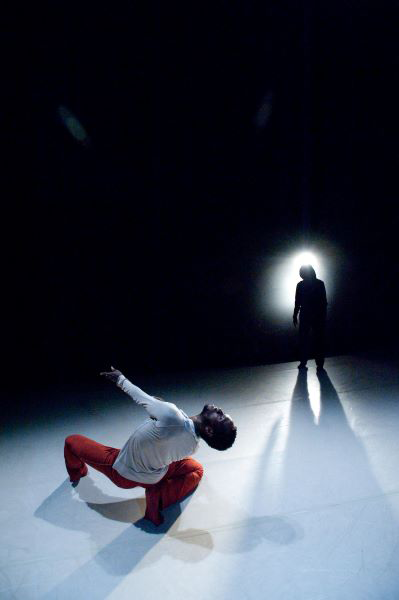Dark Matters: The Potential of Dance
Review of Crystal Pite's Dark Matters on OntheBoards.TV
Written by TeenTix Newsroom Writer Lucia McLaren and edited by Teen Editor Anya Shukla

In these dark times of uncertainty, people have access to a surprising amount of media. From Netflix to YouTube, sites give home viewers a wide library of constantly-updating content, distracting from the often anxiety-inducing situation at hand.
OntheBoards.TV, connected to TeenTix partner On the Boards, is one of these sites and holds a library of high-quality recorded contemporary art pieces. I recently watched one of these pieces, Dark Matters, a modern dance created by Crystal Pite, a Canadian choreographer who’s somewhat of an audience favorite on the site. The piece pays homage to the Frankenstein-horror sub genre through a dramatic tale of a creator and his puppet, sprinkling in sometimes out-of-place bits of humor before diving fully into themes of manipulation and connection, which can be seen throughout the entire piece, from the loose, puppet-like motion of the dancers to the music.

The show begins with a thought-provoking monologue about the fragile and fleeting quality of humankind. The spotlight is used to draw the viewer’s eyes around the onstage environment until the Frankenstein-inspired “creator” is finally revealed. Everything from the sepia-stained color palette to the intricate set design promises well-thought-out artistic decisions, and for the most part, Pite comes through on that promise.
Another strong decision, though fleeting and slightly novelistic, is the cardboard puppet used during the beginning of the piece. The dancer playing the puppet’s “creator” and the puppeteers in dark-colored hoods work together seamlessly to craft a personality in the inanimate figure. The marionette tells a story through its movement—clinging to the leg of its creator one moment and attempting to tackle him out of desperation through the next—and its actions inspire a sense of anxious curiosity in the viewer. This decision also gives the viewer insight into the various themes of the piece, with the way the puppet changes from being manipulated by its “creator” to manipulating him by the end of the section.
Even when not using a literal marionette, Pite creates a powerful impression of the theme of manipulation. The dancers seem to jolt loosely from one pose to the next, as though strings are pulling them about the space. They also use others as a way to share weight and power, moving from one shape to the next through connections with their fellow dancers.
Partnering is also used in Dark Matters to link back to the central themes. Difficult balancing and weight-sharing maneuvers are performed by each dancer at one point or another, and they execute each movement flawlessly. Throughout each duet or quintet, dancers support or manipulate each other’s weight, never dominating one side of the equation but continually switching between roles. Even in the case of the creator and the puppet, the structure of the partnering gives the viewer a strong sense of the struggle and building tension.

The soundtrack in Dark Matters also does a wonderful job of building drama. A combination of original music and sound effects is effectively used to cue the viewer in on the stakes of the scene. At its best, the music adds another crucial layer to the dancing, helping to craft the more literal story of the creator and puppet by revealing their changing relationship. Slow, soft violin chords give way to a dramatically full-orchestrated section, changing the mood of the piece in a pleasurably thought-out fashion. Unfortunately, the effectiveness of the soundtrack also turns into a detriment when dancers are left in silence. Long solos without music, beautifully crafted but sometimes one-dimensional without the aid of sound, stretch on far too long at times and can be frustrating due to the way the piece showed further complexity earlier on.
Additionally, another frustrating aspect of Dark Matters is its conflict in tone. A section in the piece dedicates itself to a strangely silly and outlandish performance, giving the audience metaphorical whiplash at the sudden shift from drama to comedy. This humorous tone is completely absent from the rest of the piece. It’s a strange artistic decision, one that can be explained by the choreographer’s wish to not stick to a single tone. However, the way the choice is so abruptly executed makes the interlude feel like a random intermission the piece would’ve done far better without.
So, overall, my opinion of Dark Matters is as follows: it’s a beautifully crafted modern dance piece with wonderfully creative artistic decisions, but one that occasionally usurps itself by going just a little too far into the unknown. However, as said at the beginning, media is incredibly important in the uncertain times that we’re currently living in. The future is undetermined, especially for youth and people in disadvantaged situations, and allowing ourselves to escape to a land like the one Pite crafts is crucial to keeping our mental and emotional states intact.
Dark Matters premiered at On the Boards in February 2011, and is currently available to watch on OntheBoards.TV.
Lead photo caption: Kidd Pivot in Dark Matters by Crystal Pite. Photo by Dean Buscher.
The TeenTix Newsroom is a group of teen writers led by the Teen Editorial Staff. For each review, Newsroom writers work individually with a teen editor to polish their writing for publication. The Teen Editorial Staff is made up of 6 teens who curate the review portion of the TeenTix blog. More information about the Teen Editorial Staff can be found HERE.
The TeenTix Press Corps promotes critical thinking, communication, and information literacy through criticism and journalism practice for teens. For more information about the Press Corps program see HERE.

